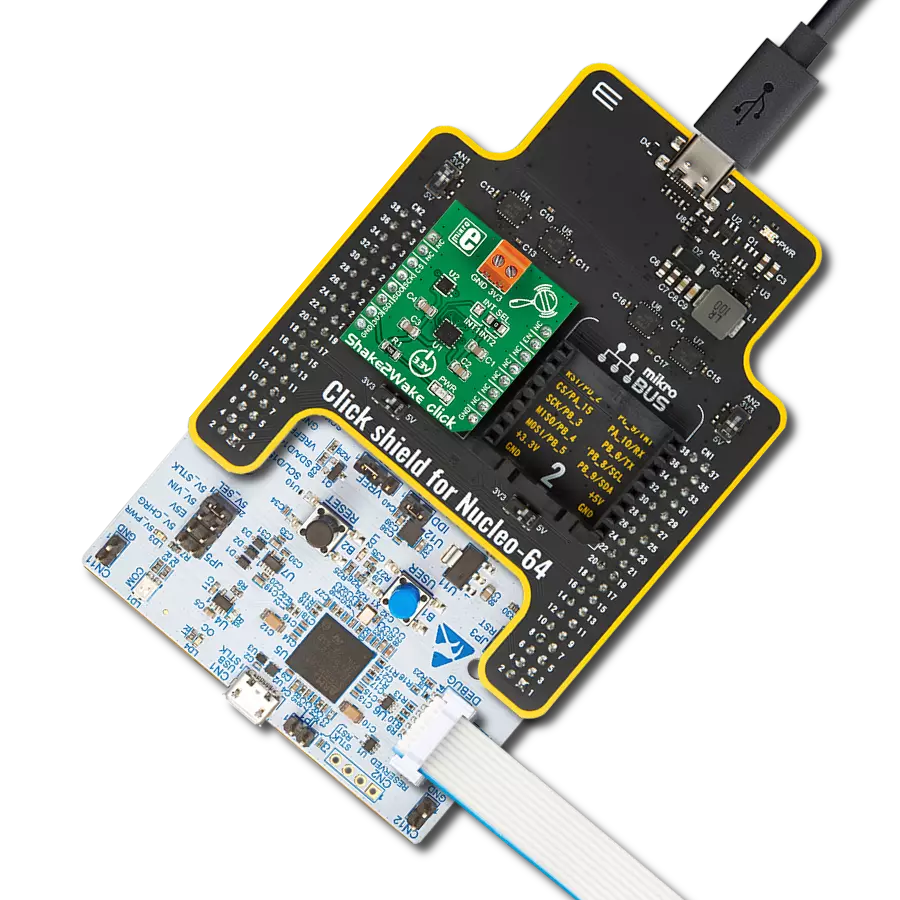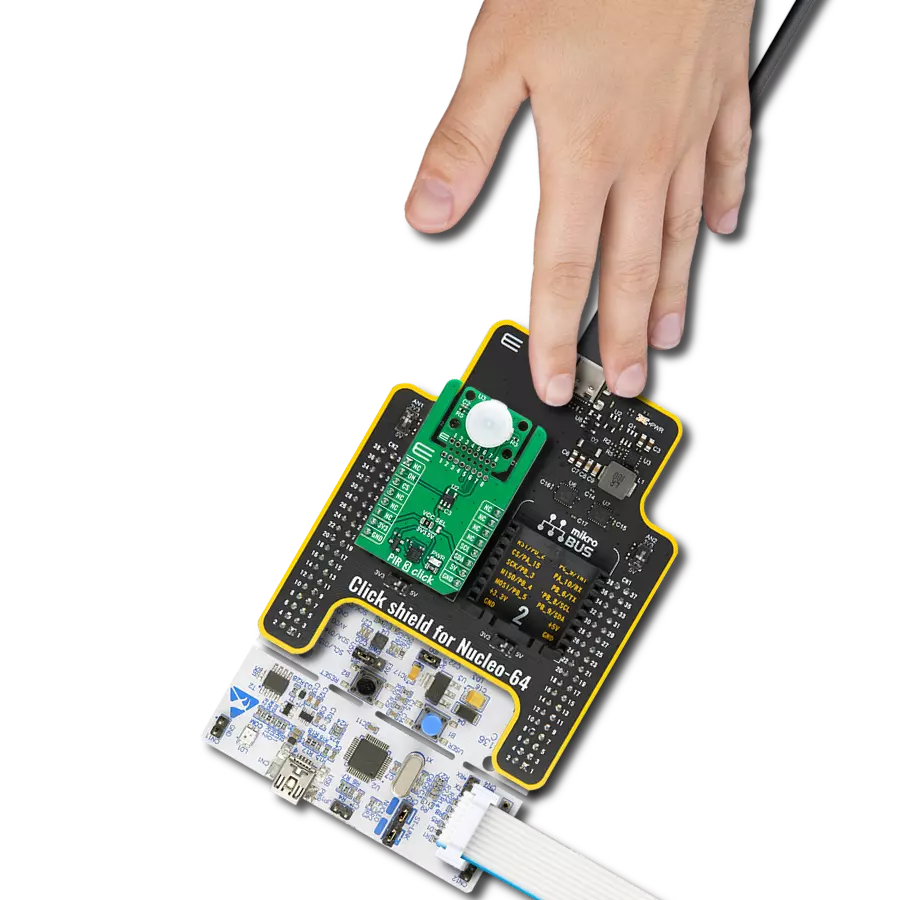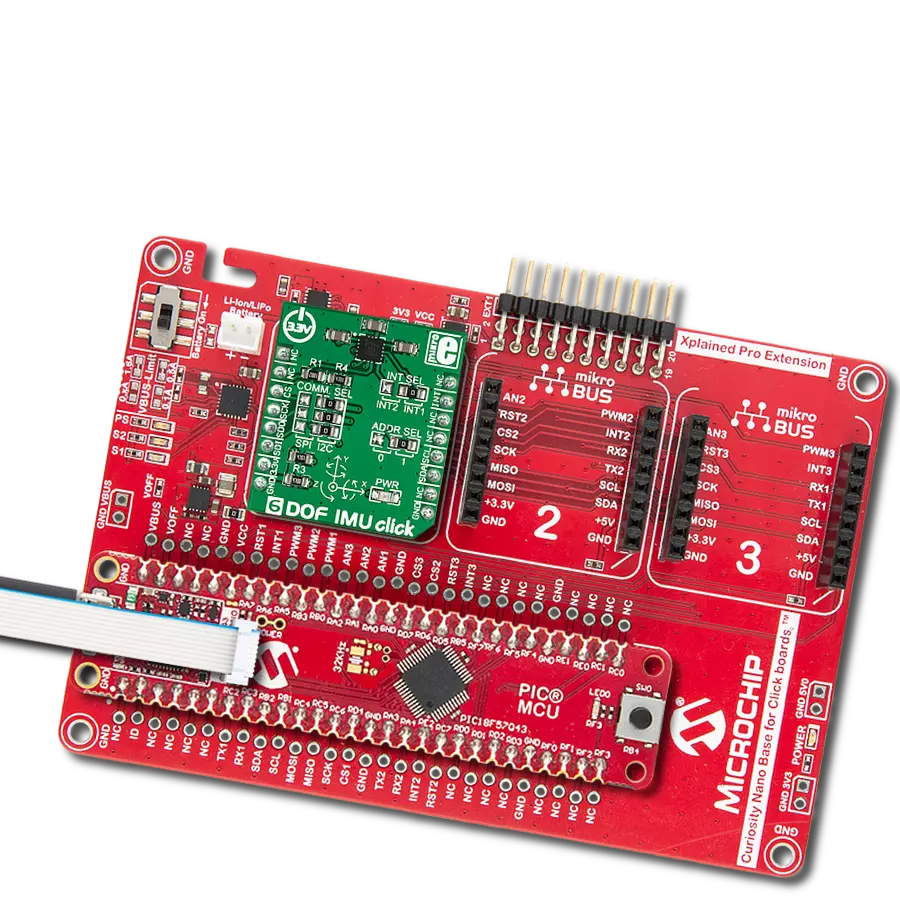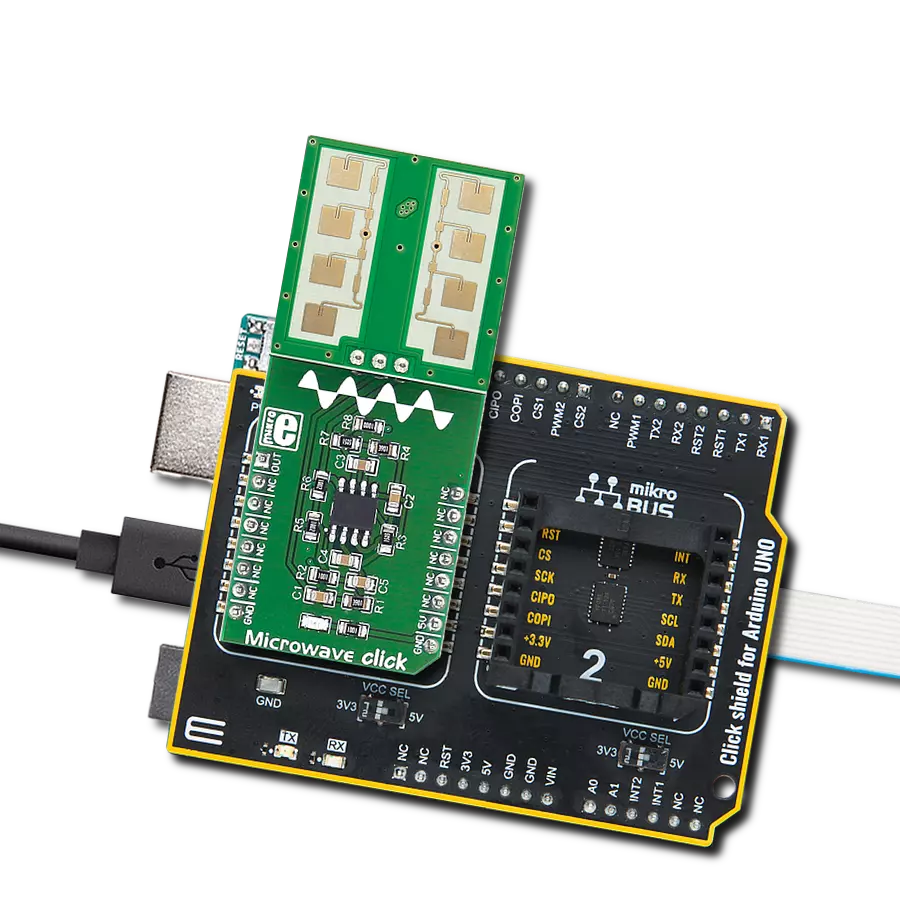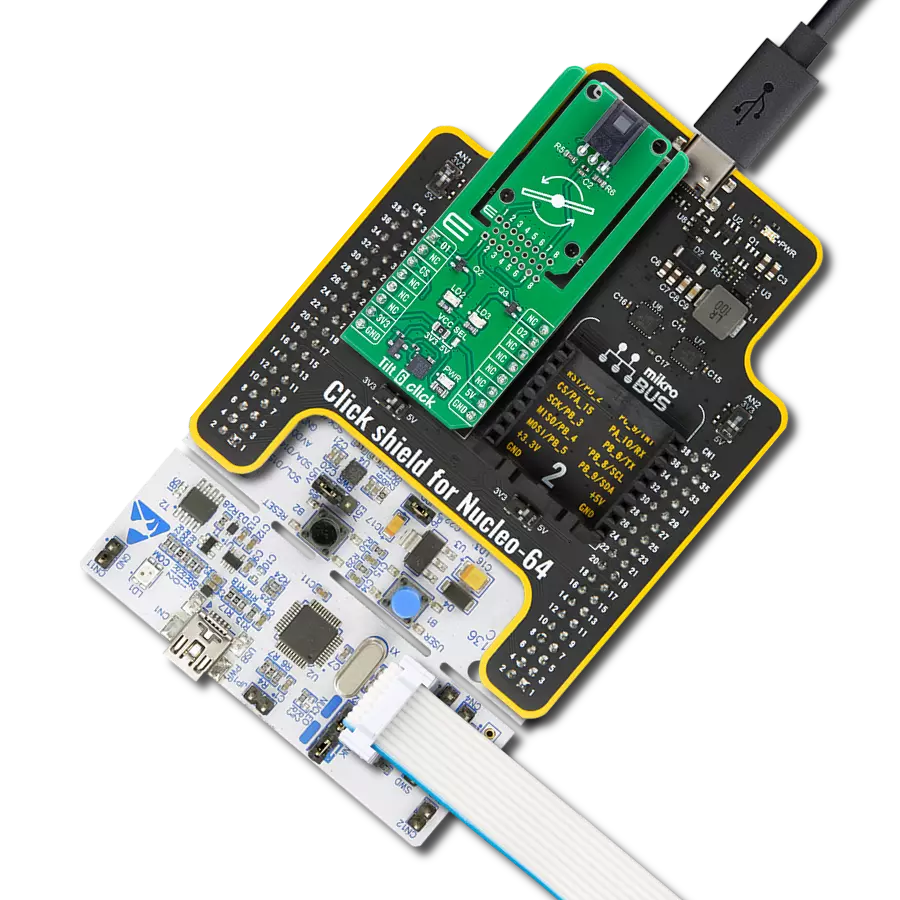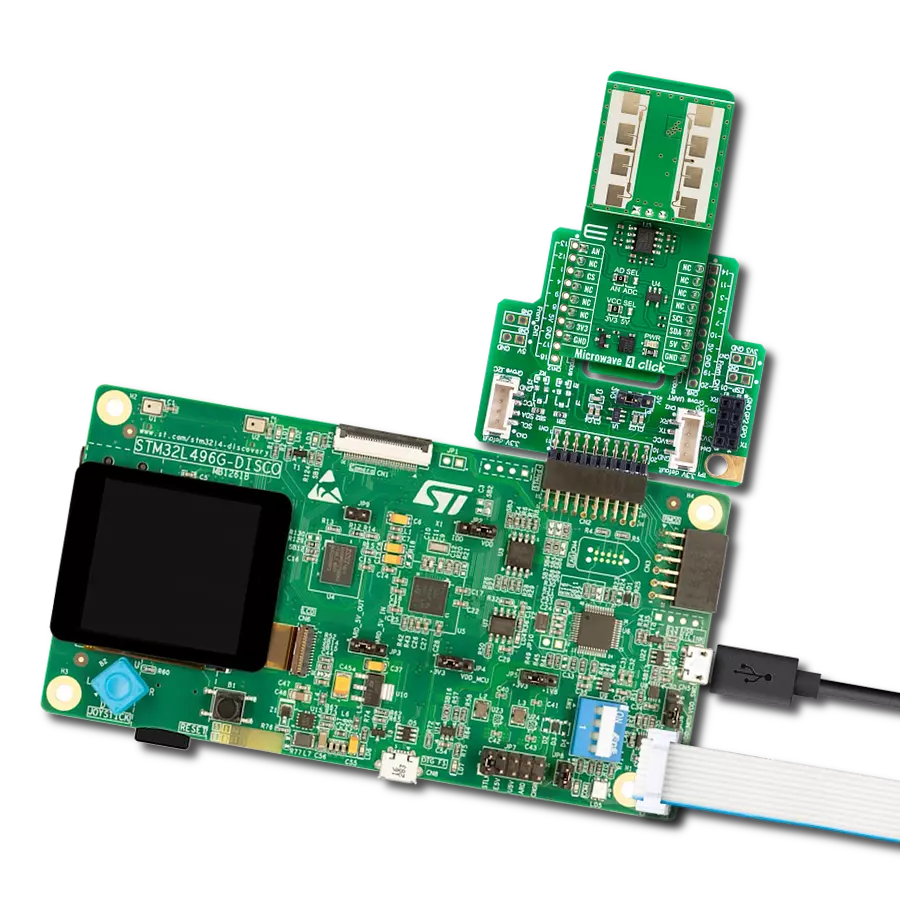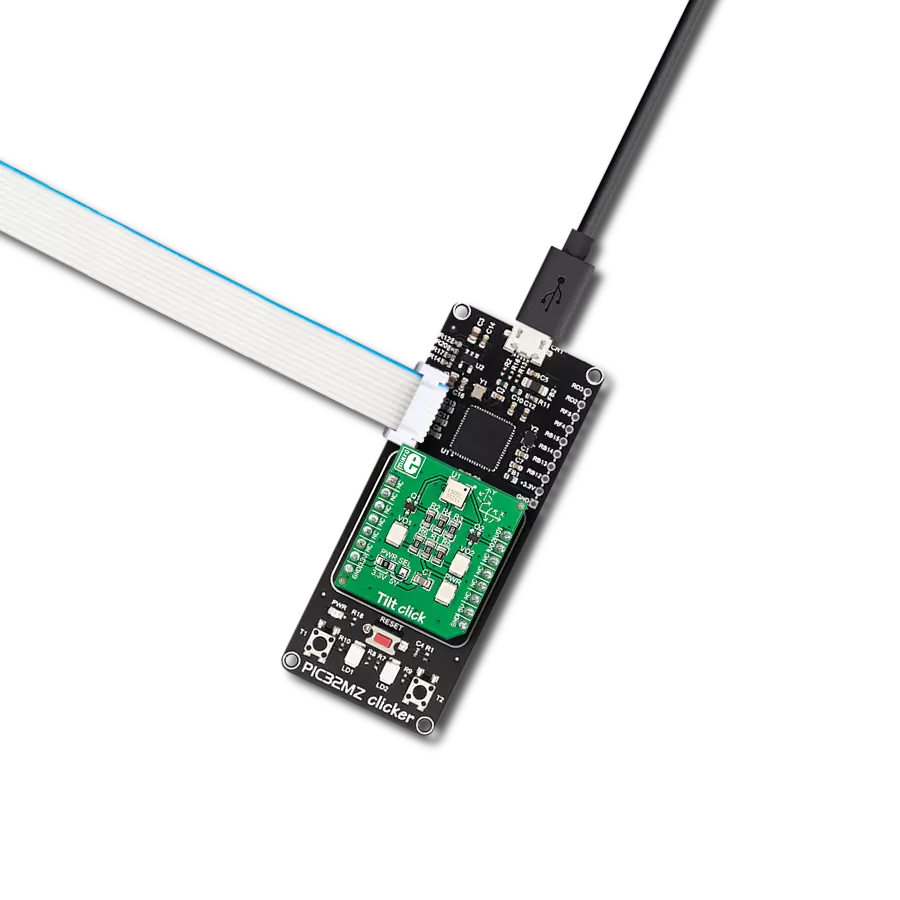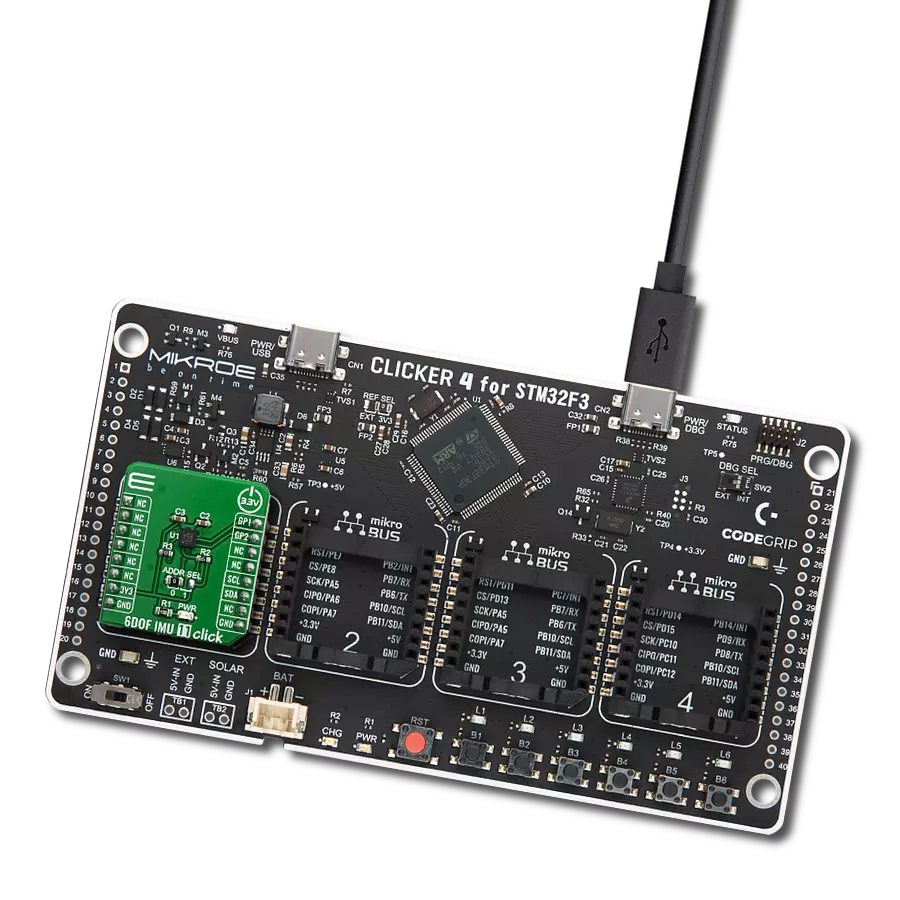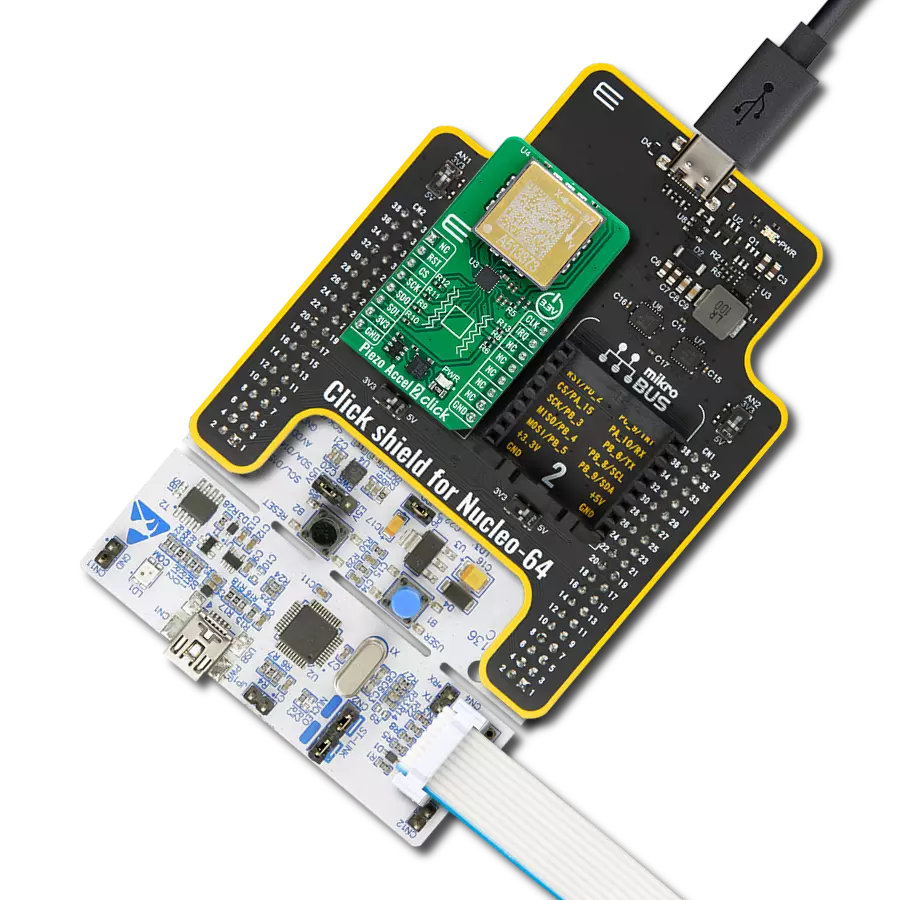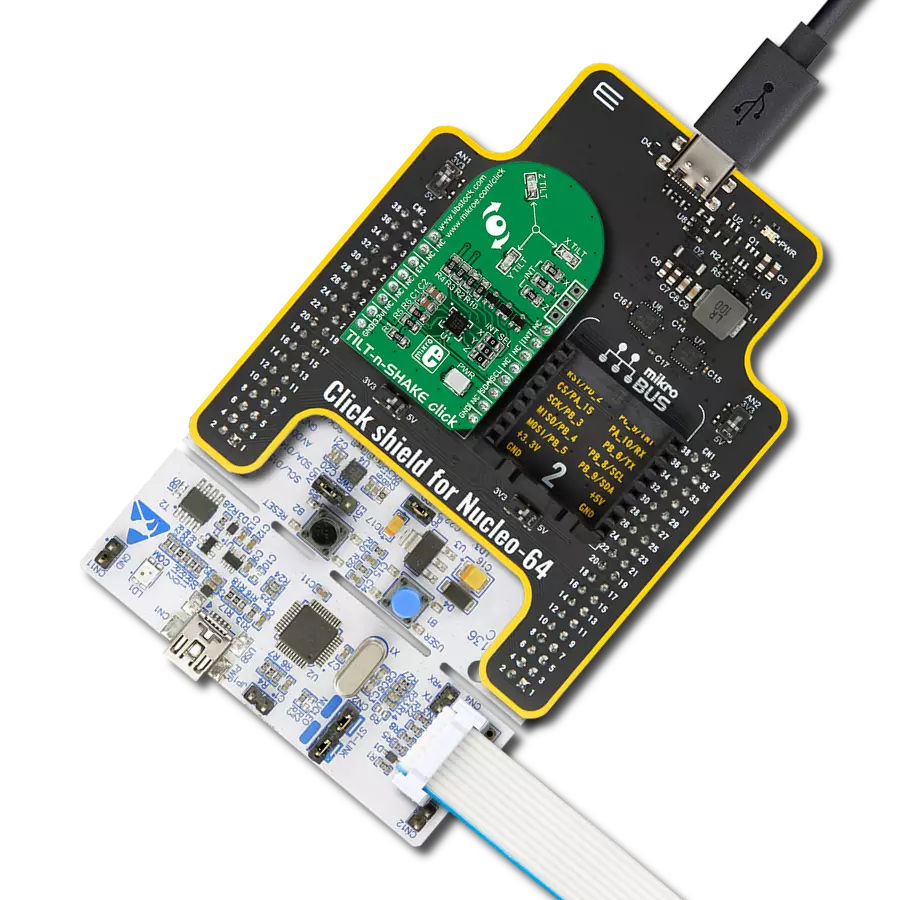Provide high-performance and reliable motion detection for various applications requiring accurate presence sensing
A
A
Hardware Overview
How does it work?
PIR 2 Click is based on the ZSLM323511, a dual-element balanced differential pyroelectric (PIR) sensor from Zilog. Designed for high performance and excellent EMI immunity, this sensor is ideal for demanding motion detection applications such as security/intrusion motion detectors, lighting control, video doorbells, and many more. The ZSLM323511 features a low-profile surface mount package compatible with IR reflow processes. It includes two sensing elements behind a spectral filter window tuned to an 8-13um wavelength, blocking out unwanted IR energy sources. With a 0.6mm element spacing, it provides additional white light protection and a typical field of view of 150 degrees from the center of the element on the X-axis and
139 degrees on the Y-axis. Combined with the ZSLM323511, the PIR 2 Click also integrates the ZCWM05GIV1 PIR lens, made from high-density polyethylene. This lens ensures maximum IR transmissivity with well-defined beam patterns. It clips directly into the Click board over the ZSLM323511 sensor, simplifying mechanical design. The MCP607, a micropower CMOS operational amplifier from Microchip, processes the ZSLM323511 raw sensor output. This unity-gain stable, low offset voltage OpAmp features rail-to-rail output swing capability and low input bias current. The buffered signal can be then converted to a digital value using the MCP3221, a 12-bit resolution successive approximation A/D converter
with a 2-wire I2C compatible interface, or it can be sent directly to an analog pin of the mikroBUS™ socket labeled as AN. Additionally, the board allows for signal monitoring at every process stage via test points, from the raw PIR sensor signal on PIR OUT to the amplified signal stages at AMP1 and AMP2 test points. This Click board™ can operate with either 3.3V or 5V logic voltage levels selected via the VCC SEL jumper. This way, both 3.3V and 5V capable MCUs can use the communication lines properly. Also, this Click board™ comes equipped with a library containing easy-to-use functions and an example code that can be used as a reference for further development.
Features overview
Development board
Arduino Mega 2560 is a robust microcontroller platform built around the ATmega 2560 chip. It has extensive capabilities and boasts 54 digital input/output pins, including 15 PWM outputs, 16 analog inputs, and 4 UARTs. With a 16MHz crystal
oscillator ensuring precise timing, it offers seamless connectivity via USB, a convenient power jack, an ICSP header, and a reset button. This all-inclusive board simplifies microcontroller projects; connect it to your computer via USB or power it up
using an AC-to-DC adapter or battery. Notably, the Mega 2560 maintains compatibility with a wide range of shields crafted for the Uno, Duemilanove, or Diecimila boards, ensuring versatility and ease of integration.
Microcontroller Overview
MCU Card / MCU
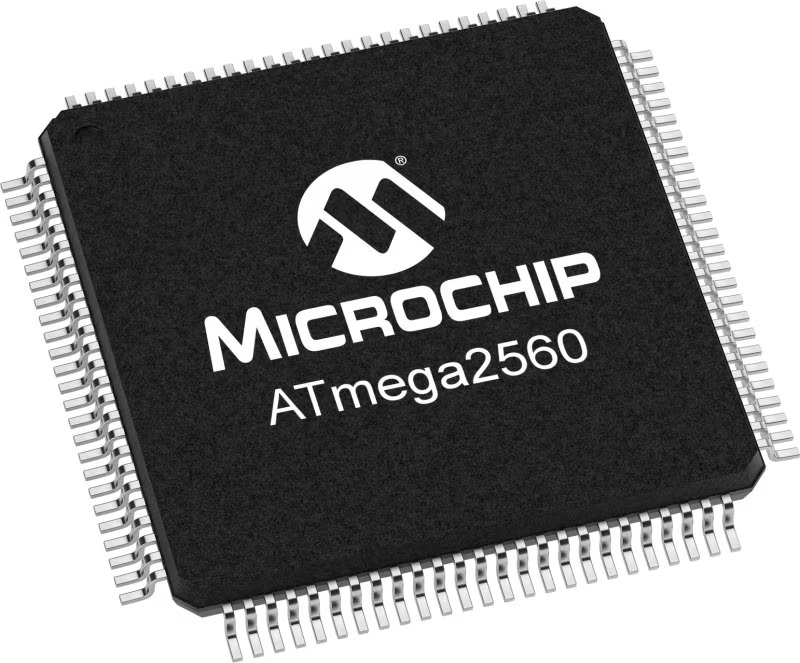
Architecture
AVR
MCU Memory (KB)
256
Silicon Vendor
Microchip
Pin count
100
RAM (Bytes)
8192
You complete me!
Accessories
Click Shield for Arduino Mega comes equipped with four mikroBUS™ sockets, with two in the form of a Shuttle connector, allowing all the Click board™ devices to be interfaced with the Arduino Mega board with no effort. Featuring an AVR 8-bit microcontroller with advanced RISC architecture, 54 digital I/O pins, and Arduino™ compatibility, the Arduino Mega board offers limitless possibilities for prototyping and creating diverse applications. This board is controlled and powered conveniently through a USB connection to program and debug the Arduino Mega board efficiently out of the box, with an additional USB cable connected to the USB B port on the board. Simplify your project development with the integrated ATmega16U2 programmer and unleash creativity using the extensive I/O options and expansion capabilities. There are eight switches, which you can use as inputs, and eight LEDs, which can be used as outputs of the MEGA2560. In addition, the shield features the MCP1501, a high-precision buffered voltage reference from Microchip. This reference is selected by default over the EXT REF jumper at the bottom of the board. You can choose an external one, as you would usually do with an Arduino Mega board. There is also a GND hook for testing purposes. Four additional LEDs are PWR, LED (standard pin D13), RX, and TX LEDs connected to UART1 (mikroBUS™ 1 socket). This Click Shield also has several switches that perform functions such as selecting the logic levels of analog signals on mikroBUS™ sockets and selecting logic voltage levels of the mikroBUS™ sockets themselves. Besides, the user is offered the possibility of using any Click board™ with the help of existing bidirectional level-shifting voltage translators, regardless of whether the Click board™ operates at a 3.3V or 5V logic voltage level. Once you connect the Arduino Mega board with Click Shield for Arduino Mega, you can access hundreds of Click boards™, working with 3.3V or 5V logic voltage levels.
Used MCU Pins
mikroBUS™ mapper
Take a closer look
Click board™ Schematic

Step by step
Project assembly
Track your results in real time
Application Output
1. Application Output - In Debug mode, the 'Application Output' window enables real-time data monitoring, offering direct insight into execution results. Ensure proper data display by configuring the environment correctly using the provided tutorial.

2. UART Terminal - Use the UART Terminal to monitor data transmission via a USB to UART converter, allowing direct communication between the Click board™ and your development system. Configure the baud rate and other serial settings according to your project's requirements to ensure proper functionality. For step-by-step setup instructions, refer to the provided tutorial.

3. Plot Output - The Plot feature offers a powerful way to visualize real-time sensor data, enabling trend analysis, debugging, and comparison of multiple data points. To set it up correctly, follow the provided tutorial, which includes a step-by-step example of using the Plot feature to display Click board™ readings. To use the Plot feature in your code, use the function: plot(*insert_graph_name*, variable_name);. This is a general format, and it is up to the user to replace 'insert_graph_name' with the actual graph name and 'variable_name' with the parameter to be displayed.

Software Support
Library Description
This library contains API for PIR 2 Click driver.
Key functions:
pir2_read_raw_adc- This function reads raw ADC value.pir2_read_voltage- This function reads raw ADC value and converts it to proportional voltage level.pir2_set_vref- This function sets the voltage reference for PIR 2 click driver.
Open Source
Code example
The complete application code and a ready-to-use project are available through the NECTO Studio Package Manager for direct installation in the NECTO Studio. The application code can also be found on the MIKROE GitHub account.
/*!
* @file main.c
* @brief PIR 2 Click Example.
*
* # Description
* This example demonstrates the use of PIR 2 Click boards.
*
* The demo application is composed of two sections :
*
* ## Application Init
* Initializes the driver and selects the driver interface.
*
* ## Application Task
* It checks if the sensor has detected movement and displays message on the USB UART.
*
* @author Stefan Ilic
*
*/
#include "board.h"
#include "log.h"
#include "pir2.h"
static pir2_t pir2; /**< PIR 2 Click driver object. */
static log_t logger; /**< Logger object. */
#define PIR2_VOLTAGE_TRESHOLD 2.5f
void application_init ( void )
{
log_cfg_t log_cfg; /**< Logger config object. */
pir2_cfg_t pir2_cfg; /**< Click config object. */
/**
* Logger initialization.
* Default baud rate: 115200
* Default log level: LOG_LEVEL_DEBUG
* @note If USB_UART_RX and USB_UART_TX
* are defined as HAL_PIN_NC, you will
* need to define them manually for log to work.
* See @b LOG_MAP_USB_UART macro definition for detailed explanation.
*/
LOG_MAP_USB_UART( log_cfg );
log_init( &logger, &log_cfg );
log_info( &logger, " Application Init " );
pir2_drv_interface_sel( &pir2_cfg, PIR2_DRV_SEL_I2C );
// Click initialization.
pir2_cfg_setup( &pir2_cfg );
PIR2_MAP_MIKROBUS( pir2_cfg, MIKROBUS_1 );
err_t init_flag = pir2_init( &pir2, &pir2_cfg );
if ( ( ADC_ERROR == init_flag ) || ( I2C_MASTER_ERROR == init_flag ) )
{
log_error( &logger, " Communication init." );
for ( ; ; );
}
log_info( &logger, " Application Task " );
}
void application_task ( void )
{
float voltage = 0;
pir2_read_voltage ( &pir2, &voltage );
if ( voltage > PIR2_VOLTAGE_TRESHOLD )
{
log_printf( &logger, " Motion detected \r\n" );
Delay_ms ( 1000 );
}
}
int main ( void )
{
/* Do not remove this line or clock might not be set correctly. */
#ifdef PREINIT_SUPPORTED
preinit();
#endif
application_init( );
for ( ; ; )
{
application_task( );
}
return 0;
}
// ------------------------------------------------------------------------ END
Additional Support
Resources
Category:Motion




















